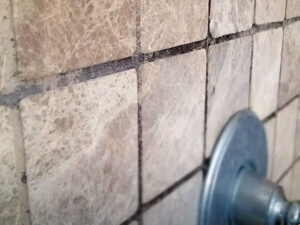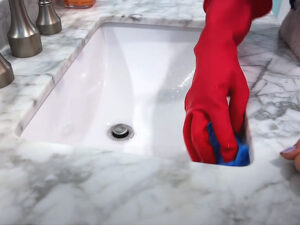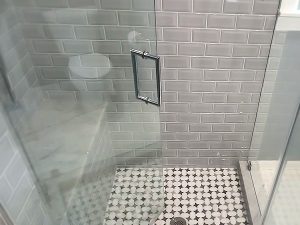Have you ever heard odd gurgling noises coming from your bathroom sink or noticed that it is draining slowly? It might have gunk in it! Hair, soap residue, and other grimy materials may accumulate in the drain over time, causing water to pool and decreasing the efficiency of your sink.
Despite what you may think, clearing the debris from your sink drain is not as difficult as it seems! In this post, we’ll look at easy, step-by-step techniques for cleaning the drain in your bathroom sink using common household products.
We’ll take you through many methods to get your sink shining and draining like new, from simple items like plungers to homemade concoctions of vinegar and baking soda. Say goodbye to gunk and ensure a smooth, clean sink for a cleaner, fresher bathroom experience by following these simple steps!
Steps to Clean Gunk Out of Your Bathroom Sink Drain
One easy maintenance activity that may help maintain good drainage and avoid jams is cleaning gunk out of a bathroom sink drain. Hair, soap residue, toothpaste, and other debris may build up in the drain over time and cause partial or total blockages that impede the flow of water. This is a step-by-step guide on clearing muck from the drain in your bathroom sink:

Supplies and Equipment Needed
- Rubber Gloves: Wear gloves to protect your hands from dirt and debris.
- Bucket: You’ll need a bucket to catch the water and debris that comes out of the drain.
- Plunger: A sink plunger can help dislodge some of the gunk.
- Pliers: Use pliers to remove the sink stopper or drain plug (if applicable).
- Zip-It Tool or Drain Snake: These tools can help you reach and remove gunk deep within the drain.
- Baking Soda: Baking soda can help break down grease and odors.
- Vinegar: White vinegar can help dissolve organic matter and freshen the drain.
- Boiling Water: Boiling water can help flush out debris and clear the drain.
Step 1: Make the Area Clear
Make sure your workstation is tidy and orderly before starting to clear the muck out of your bathroom sink drain. Verify that nothing might get in the way of your job when working beneath the sink, including objects or impediments.
To collect any water or debris that may spill during the cleaning procedure, have a pail or towel close at hand. You’ll find the task simpler and less untidy if you begin in a clean space.
Step 2: Take Out the Sink Stopper, if necessary
Before you can reach the drain, you may need to remove a stopper or plug from some bathroom sinks. You usually locate a nut holding the pop-up stopper in place if your sink has one. To remove the stopper, use pliers to loosen or unscrew this nut.
For advice on how to remove stoppers, go to the manufacturer’s instructions since various sinks could have different kinds. This is an important step because it gives you access to the drain so you can clean it more thoroughly.
Step3: Give the Plunger a Go
Consider using a sink plunger to help loosen some of the debris obstructing the drain after you’ve removed the sink stopper. Make careful to push down forcefully to produce a tight seal after placing the plunger over the drain hole. The plunger should then be forcefully pushed and pulled up and down.
Pressure fluctuations brought about by this action have the potential to loosen debris from the drain. After a few tries, take out the plunger to see whether the water flows out more easily. It’s an easy way to unclog little obstructions, but it works well.
Step 4: Use a Drain Snake or Zip-It tool
It’s time to utilize a Zip-It tool or a drain snake if the plunger isn’t able to remove all of the sludge or if the blockage is very tenacious. With the purpose of removing debris, these instruments are designed to reach further down the drain. Twist the tool into place into the drain and gently press it down.
It could be twisted with hair, soap scum, and other detritus as you bring it back up. Until no more substantial muck comes out, keep going through this procedure. These equipment are useful for do-it-yourself drain cleaning since they are inexpensive and simple to use.
Step 5: Prepare a Vinegar and Baking Soda Solution
The next step in unclogging your bathroom sink drain entails using a simple but efficient DIY method. White vinegar and baking soda are required for this. To begin, start by emptying the drain of about half a cup of baking soda.
Baking soda works wonders for removing smells, dissolving fats, and facilitating cleaning. Next, add half a cup of white vinegar to the mixture. These two ingredients work together to produce a fizzy reaction that aids in the dissolution of organic debris and further loosens the buildup within the drain. Let this mixture stand for ten to fifteen minutes.
Step 6: Use boiling water to flush
Now that the vinegar and baking soda solution has had some time to do its job, it’s time to pour boiling water down the drain. Carefully pour hot water from a kettle down the drain. The dissolved particles and any leftover muck are helped to be flushed away by the hot water.
Handle boiling water carefully to prevent burns or scalds. This step is crucial because it guarantees that all of the loose material is removed completely, leaving your drain clear and free-flowing.
Step 7: If necessary, reassemble the sink stopper.
If you took the sink stopper out in Step 2, you may put it back together now that the cleaning is finished. Locate the nut you previously removed from the pop-up stopper on your sink, and use pliers to tighten it firmly.
This guarantees the stopper works properly and seals the drain when required. It’s possible that different sink stopper types have different reassembly procedures, so if in doubt, consult the manufacturer’s instructions.
Step 8: Run Water
To check the effectiveness of your cleaning efforts, turn on the faucet and run hot water for a few minutes. There shouldn’t be any strange gurgling or leftover debris, and the water should run down the drain more swiftly and easily. Not only does running hot water guarantee that the blockage has been removed, but it also makes sure that any leftover residue is drained out. To keep your sink drain clear and clean, you must follow this procedure.
Step 9: Continual Upkeep
Consider carrying out some periodic maintenance procedures to keep your bathroom sink drain clear and avoid future obstructions. A useful preventative step is to use a strainer in the sink.
Before material like hair and soap scum can go down the drain, it is caught by a sink strainer that is put over the entrance. By using this simple tool, you may drastically lower the incidence of obstructions and minimize the need for regular cleaning.
Step 10: Get Rid of Debris Correctly
Lastly, don’t forget to properly dispose of any waste you’ve gathered during the cleaning procedure. Throw away any items extracted using the drain snake or Zip-It tool, as well as the debris in the bucket.
Refrain from flushing it down the toilet or sink as this may cause further blockages or plumbing problems. You may avoid further issues and maintain the functionality of your bathroom sink drain by properly disposing of the debris.
Are There Any Alternative Methods?
Yes, if the previously described basic techniques don’t work or if you prefer a different strategy, there are other ways to clear muck out of a bathroom sink drain. Here are a few substitute techniques:
1. DIY Drain Cleaner (Baking Soda and Salt)
If you don’t have vinegar on hand, you may make an efficient homemade drain cleaner using simple everyday objects. Combine equal amounts of baking soda and salt, usually about a cup each, then pour the mixture straight down the sink drain. Give it a good 15 to 30 minutes to sit.
Together, the baking soda and salt help dissolve debris and unclog the drain. When the time has passed, flush the dissolved material out of the drain by running boiling water down it. This technique might be a great substitute for chemical drain cleaners since it is easy on your plumbing system.
2. Industrial Cleaners for Drains
Products for cleaning commercial drains are easily found in most retailers. Strong chemicals in these solutions are usually used to dissolve muck and obstructions in drains. It’s important to use them according to the manufacturer’s directions exactly.
Certain chemicals may be hazardous, so use caution and protect your eyes and hands with gloves. When all other options are exhausted, you should use commercial drain cleaners as a last resort. However, you should use them cautiously to prevent any possible plumbing damage.
3. Baking Soda and Hydrogen Peroxide
Baking soda and hydrogen peroxide together may be a useful, non-toxic solution for clearing blockages in your sink drain. First, combine baking soda and hydrogen peroxide in equal amounts to make a paste. Cover all of the gunky parts of the drain’s inside with this paste.
Leave it to rest for a few hours or even better, overnight. The paste will try to break down the smells and muck during this period. After that, run boiling water down the drain to remove the unfastened material. This approach is safe for the environment as well.
4. The Plumbing Snake or Plumbing Auger
A more sophisticated instrument for clearing stubborn clogs is a plumbing auger, also referred to as a plumbing snake. It’s a long, flexible wire that can reach deep down the drain to clear obstructions. It has an end that resembles a corkscrew.
Turn the handle of the auger to move it into the pipe until it grips onto the muck after inserting it into the drain. To get rid of the material, slowly extract the auger. When dealing with more difficult blockages that other techniques may not be able to tackle, plumbing augers can be quite helpful.
5. Scrubbing Agents
Chemical drain cleaners may be replaced with environmentally friendly enzyme-based drain cleaners. Natural enzymes included in these products decompose organic materials like soap scum and hair. Although they are better for the environment and your pipes, they operate more slowly than chemical cleansers.
Just do as directed on the label of the product, which often calls for pouring the solution down the drain and waiting for a certain period of time. In particular, enzyme cleansers are helpful for upkeep and averting new blockages.
6. Expert Assistance
When all DIY solutions have failed and the clog still won’t go away, it’s time to think about getting expert assistance. With their specialized gear and knowledge, plumbers can handle even the most difficult blockages and maintain the integrity of your plumbing system.
If you are worried about damaging your pipes or if your attempts are not working, don’t be afraid to contact a professional. They are able to identify and fix the problem fast.
Keep in mind that the best way to deal with muck accumulation in your sink drain is often prevention. Reducing the frequency of blockages and the need for thorough cleaning may be achieved by using a sink strainer to capture material before it reaches the drain and by routinely cleaning the pop-up assembly or stopper.
Final Words
You can avoid annoying blockages and maintain the smooth operation of your sink with a few basic tools and the correct knowledge. Recall that preventing future blockages may be greatly increased by performing routine maintenance and taking preventative measures, such as utilizing a sink strainer.
You can make sure your bathroom sink is clean and effective by following the instructions in our guide and, if necessary, thinking about other options. Remember that eco-friendliness and safety are paramount, and choose items and procedures in keeping with these values. You may have a nice, gunk-free bathroom sink for many years to come with a little work and the advice we’ve offered.







